Learn how to navigate around iPadOS, select menus, click items, toggle buttons, scroll lists, and control your iPad by using the physical keyboard, with no screen touching required.
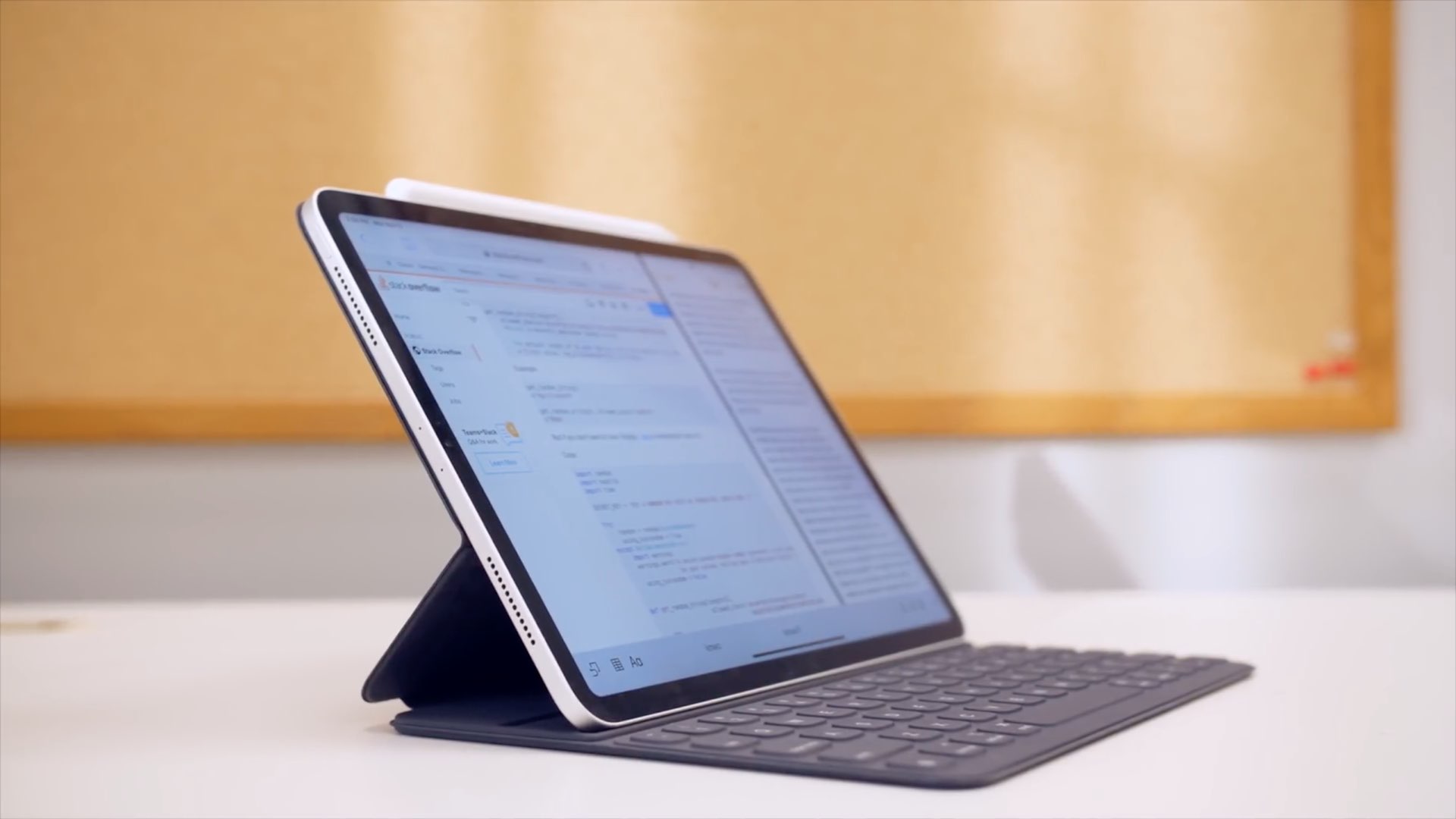
While iPad is a touch-based device, the Full Keyboard Access accessibility feature in iPadOS allows using a keyboard to navigate around the user interface. This is useful for people with physical disabilities who find it difficult to touch the screen.
Also see: How to control your iPad pointer with a physical keyboard
Full Keyboard Access is off by default, so you must first turn the feature on.
- Connect a physical keyboard to your iPad.
- Open the Settings app on your iPad and tap Accessibility.
- Tap Keyboards & Typing.
- Select Full Keyboard Access underneath the Hardware Keyboards heading.
- Turn on the switch for Full Keyboard Access.

That’s it; you can now use your external keyboard to control and navigate your iPad.
When Full Keyboard Access is on, you’ll see a rectangular selection outline around the currently selected onscreen element, like a button or a list. This tells you which part of the interface will receive input from you. There are plenty of keyboard shortcuts you can use to move around the entirety of the iPadOS user interface, as well as interact with various onscreen items.
You can also access iOS’s features like Notification and Control Center and perform device-specific actions, such as restarting. Because of the number of keys involved in iPad keyboard navigation, the feature can be a bit overwhelming at first, but soon, you’ll be moving around iPadOS and using your apps without touch like a pro. Don’t worry; we have you covered, so read on for the full explanation.
To make your life easier, Apple has provided nearly a dozen keyboard shortcuts to perform special iOS actions, like jumping to the Home Screen or activating the App Switcher.
You can see all these shortcuts by going to iPad Settings > Accessibility > Keyboards & Typing > Full Keyboard Access > Commands. On this page, you will see key names (like Tab) as well as key icons (like ⌘). Here’s what they mean:
- ⇥ : Tab key
- ⇧ : Shift key
- ⌥ : Option key
- ⌃ : Control key
- ⌘ : Command key
- ↑ : Up arrow key
- ↓ : Down arrow key
- ← : Left arrow key
- → : Right arrow key
Scroll down for all the keyboard shortcuts you can use with Full Keyboard Access.
Moving the selection rectangle
To move the selection rectangle from one onscreen element to another, use these shortcuts:
- Move the selection rectangle forward: Tab
- Move the selection rectangle backward: Shift + Tab
- Move the selection rectangle up: Up Arrow
- Move the selection rectangle down: Down Arrow
- Move the selection rectangle left: Left Arrow
- Move the selection rectangle right: Right Arrow
- Move the selection rectangle to the beginning: Tab + Left Arrow
- Move the selection rectangle to the end: Tab + Right Arrow
- Move the selection rectangle to the next item: Control + Tab
- Move the selection rectangle to the previous item: Control + Shift + Tab
Here are a couple of examples:
When on the Home Screen, use the arrow keys to move around the icon grid, then select/highlight a desired icon and press the Space bar to launch its app.

To see a list of actions associated with the currently highlighted item (like the app icon on the Home Screen), press Tab + Z. These item-specific actions are built-in and cannot be customized.

Interactions
What about basic iOS interactions, such as swiping to go back to the previous section or tapping? Well, you can hit the Space bar to “tap” or “press” an item or activate whatever is currently highlighted. Pressing Tab + B simulates swiping from the left edge of the screen to the right, which in many apps is the same as tapping the Back option.
Here are all the interaction shortcuts that Full Keyboard Access provides:
- Tap/press toggle buttons or activate the selection: Space Bar
- Go back: Tab + B
- Search the onscreen buttons: Tab + F
- Actions for the highlighted item: Tab + Z
The Tab + F shortcut is especially interesting. Hitting the combination brings up a small search field where you can type to search the available onscreen objects that can be selected or interacted with. These can be anything from icons and buttons to various toggles, tabs, and whatnot.
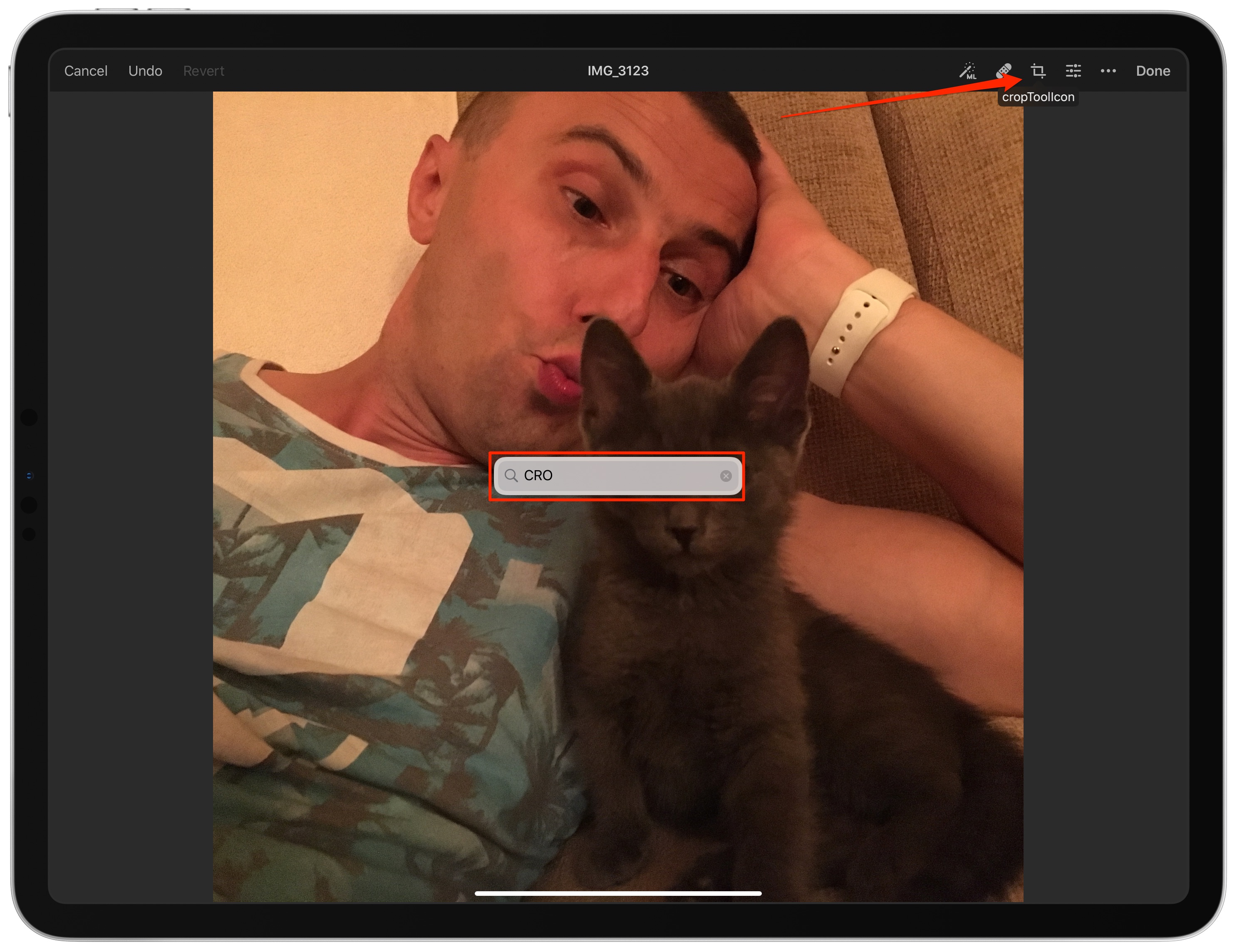
For instance, if you have too many apps on the Home screen, Tab + F lets you quickly find an app you’d like to launch by typing just a few letters, which will prompt Full Keyboard Access to highlight matches on the Home screen.
Upon entering the tab overview screen, use the arrow keys and other navigation shortcuts to move around a grid of tab thumbnails, then press the Space bar to activate the selected tab.
iOS and device features
Full Keyboard Access includes shortcuts to access various iOS and device-specific features:
- Home Screen: Fn + H or Command + H
- App Switcher: Fn + up arrow
- Control Center: Fn + C
- Notification Center: Fn + N
- Siri: Fn + S
- Accessibility Shortcuts: Tab + X
- Dock: Fn + A or Option + Command + D
- Lock the device: Tab + L
- Rotate the device: Tab + R
- Restart the device: Control + Option + Shift + Command + R
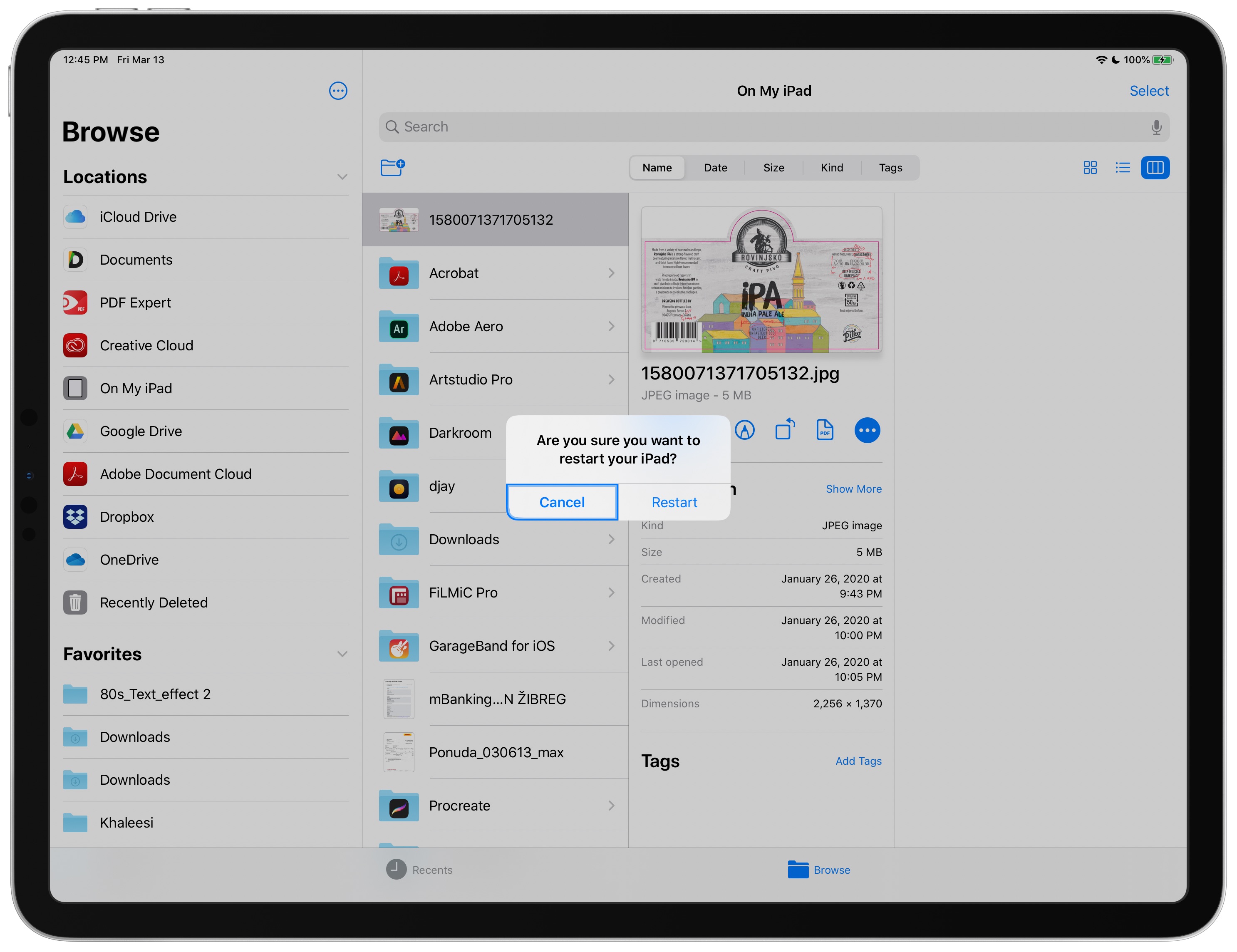
Full Keyboard Access features
Full Keyboard Access includes a few keyboard shortcuts to manage its own special features that have nothing to do with standard iOS features. As an example, you can gather Full Keyboard Access analytics at any time by pressing a fairly complex keyboard shortcut.
We’ve listed these shortcuts for you down below; here they are:
- Analytics: Control + Option + Shift + Command + Period (.)
- Pass-through mode: Control + Option + Command + P
- Keyboard shortcuts: Tab + H
Pass-through mode is very cool.
Simply hit Control + Option + Command + P to have Full Keyboard Access temporarily stop listening for your keyboard input so you can interact with iOS like you normally would. For instance, entering this mode while browsing websites in Safari lets you scroll the webpage up and down by pressing the arrow keys without Full Keyboard Access getting in the way.
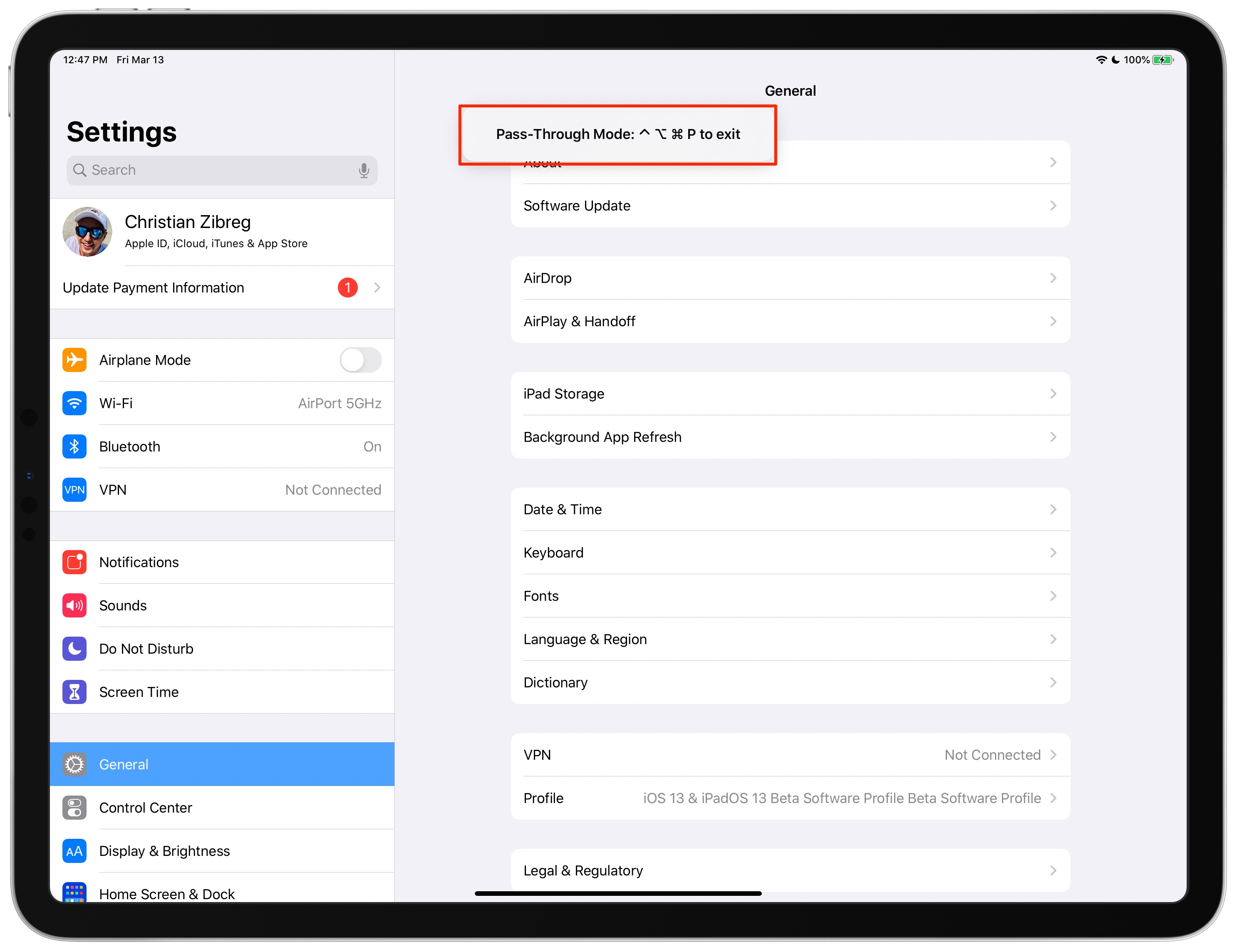
And if you get lost in all those shortcuts, help is just a keystroke away: Tab + H displays an overlay with all of the Full Keyboard Access keyboard shortcuts, including any custom ones.
Keyboard gestures
What about multi-touch gestures? How does Full Keyboard Access handle those?
Just hit Tab + G for a small overlay listing keyboard gestures that simulate their multi-touch counterparts, like pinching and swiping. You must press Tab + G for Full Keyboard Access to start listening for keyboard gestures. To exit this mode, press Tab + G again.
Here are all the keyboard gestures you can use with Full Keyboard Access. Note that if you are on a newer version of iPadOS, these gestures may not be assigned, but you can do that by going to the Commands screen (explained later below).
- Enable/disable keyboard gestures: Tab + G
- Single-finger tap or press: Space Bar
- Two-finger tap: Shift + Space Bar
- Single-finger swipe up: Up Arrow
- Single-finger swipe down: Down Arrow
- Single-finger swipe left: Left Arrow
- Single-finger swipe right: Right Arrow
- Two-finger swipe up: Shift + Up Arrow
- Two-finger swipe down: Shift + Down Arrow
- Two-finger swipe left: Shift + Left Arrow
- Two-finger swipe right: Shift + Right Arrow
- Zoom in: Command + Up Arrow
- Zoom out: Command + Down Arrow
- Rotate left: Command + Left Arrow
- Rotate right: Command + Right Arrow
For instance, entering keyboard gesture mode in Messages, moving the selection rectangle to the chat list, and pressing Shift + Space to simulate a two-finger tap allows you to select multiple chats at once without ever touching the screen. By the way, you can perform the same trick — with or without Full Keyboard Access — in other apps such as Mail, Notes, and Files.
When viewing an image or video in Photos, you can zoom in and out by holding down the Command key and pressing the up or down arrow key. And when in Photos’ edit mode, press Command + left or right arrow to rotate the selection clockwise, 90 degrees at a time.
Keyboard cheat sheets
Don’t worry about getting lost in all those commands because a handy cheat sheet of all the keyboard shortcuts for Full Keyboard Access is available with a handy Tab + H combo.
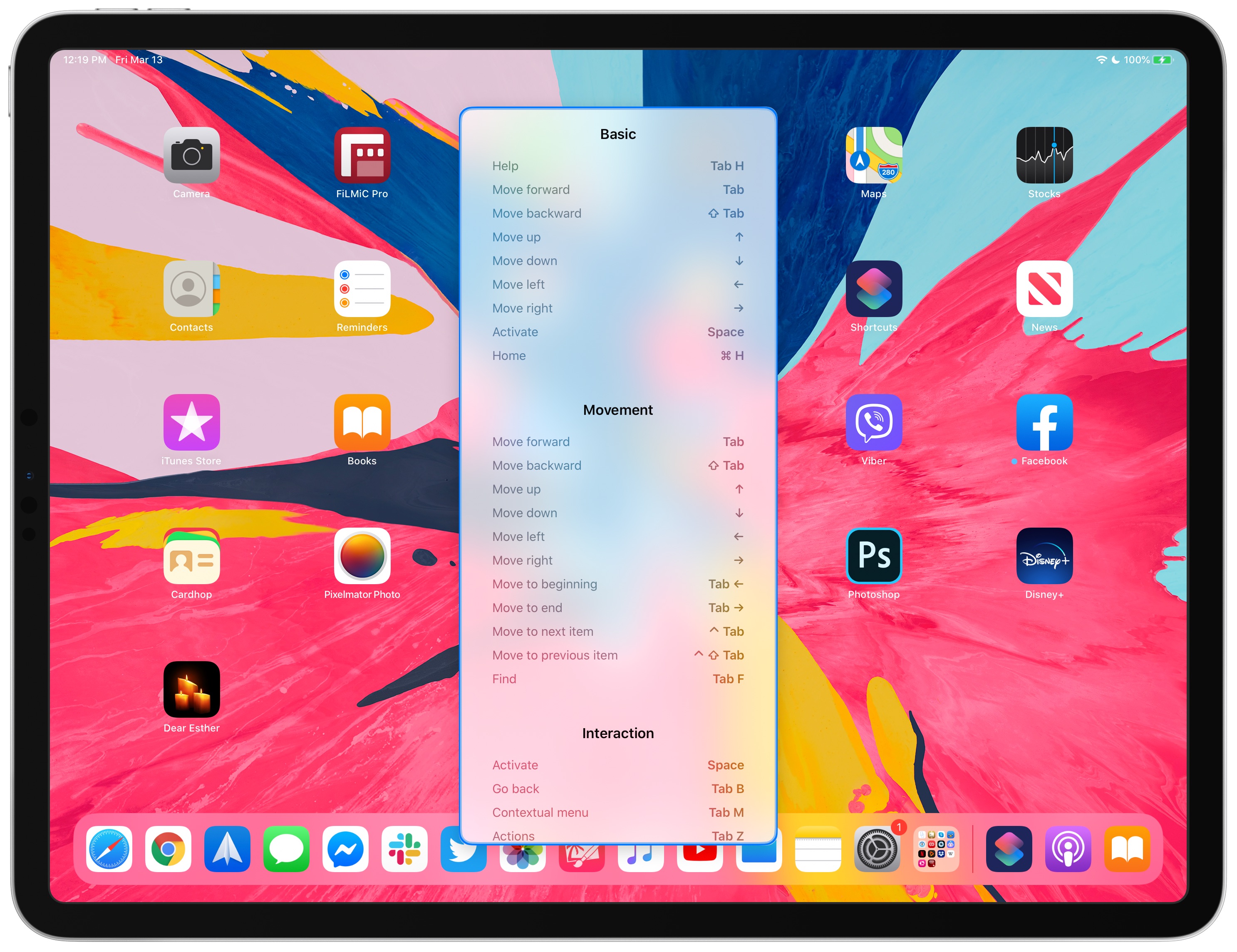
These two keyboard shortcuts are available whenever you need help:
- Display built-in and custom keyboard shortcuts for Full Keyboard Access: Tab + H
- Display keyboard shortcuts for the app you’re using: hold down the Command key
The other shortcut, holding down the Command key, isn’t exclusive to Full Keyboard Access.
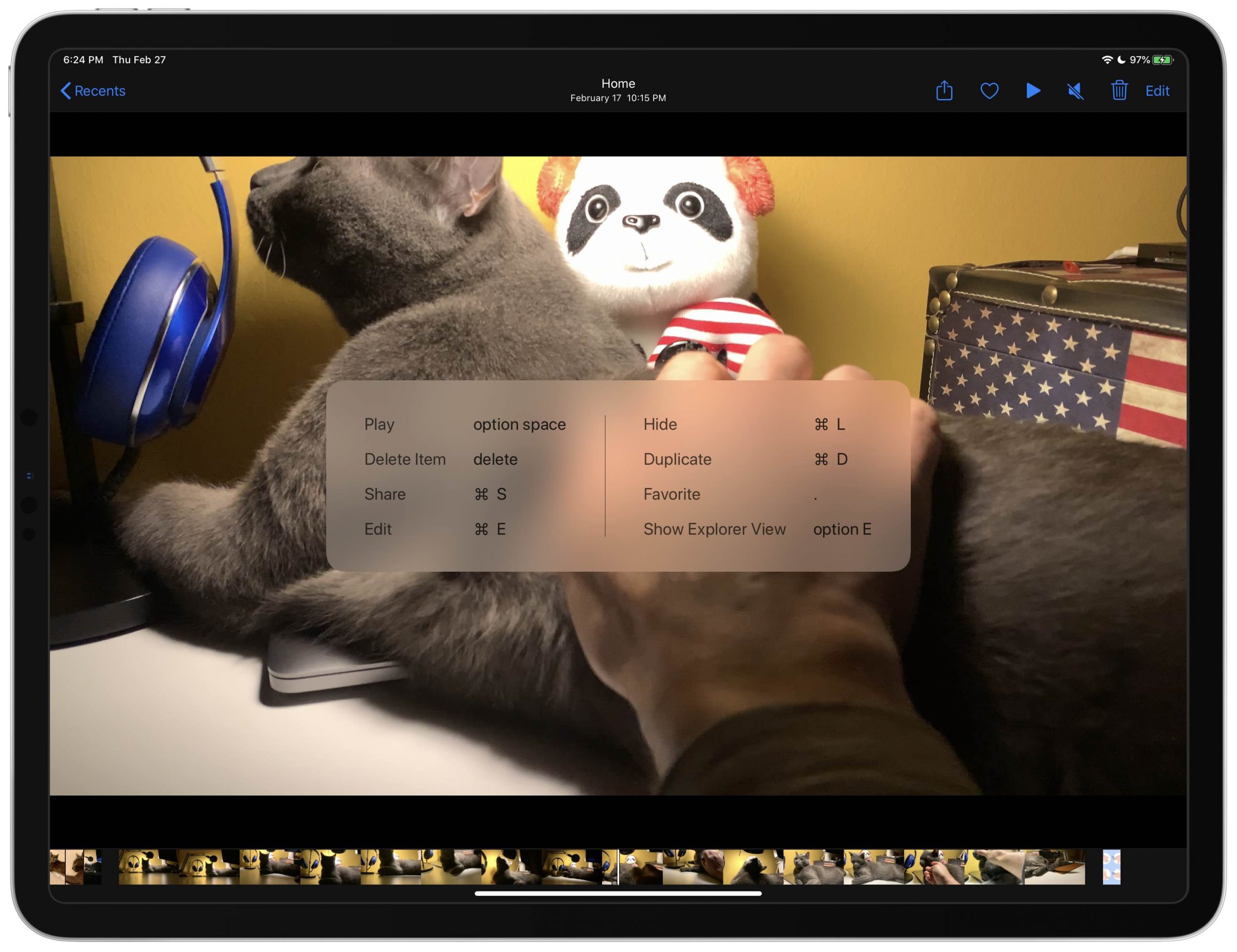
Full Keyboard Access comes with a set of Apple-defined keyboard shortcuts that will get the job done for most users, but power users may want something different to fit their workflow.
Follow the steps below to learn how to change existing shortcuts for Full Keyboard Access, as well as add your own or clear any listed keyboard combination.
- Go to iPad Settings > Accessibility > Keyboards & Typing > Full Keyboard Access > Commands.
- Choose any command from the list to customize its keyboard shortcut.
- Press a combination of keys on the keyboard to activate the chosen command.
- Tap Done to save your new keyboard shortcut or Cancel to forget it.
Of course, none of the Full Keyboard Access shortcuts are active while pressing custom key combinations to invoke the selected command. After setting the keyboard shortcut, you’ll need to type two spaces quickly to stop recording, at which point you can use Tab navigation shortcuts to select a command from the menu to save or forget your customization.

Apple’s done a good job defining keyboard shortcuts for Full Keyboard Access that don’t clash with iOS’s existing ones. But each of us has different needs and what works for me may not necessarily work for you, and vice versa. Thankfully, Apple lets you not only delete your own custom keyboard shortcuts for Full Keyboard Access but also built-in ones.
- Head to iPad Settings > Accessibility > Keyboards & Typing > Full Keyboard Access > Commands.
- Choose a listed command that has a keyboard shortcut attached to it.
- Tap Clear from the popup menu, and the selected action’s keyboard shortcut will be deleted immediately.
Assign keyboard shortcuts to run Siri Shortcuts
If you’re big on iOS automation, this will be music to your ears — Full Keyboard Access even lets you attach a system-wide keyboard combination to your favorite Siri Shortcut.
- Make sure you are in iPad Settings > Accessibility > Keyboards & Typing > Full Keyboard Access > Commands.
- Tap a shortcut underneath the Shortcuts heading.
- Press a key combination on the keyboard.
- Tap Clear to save it or Cancel to abandon the changes.
You can also choose Clear from the popup menu to clear the keyboard shortcut and start over (remember, typing two spaces quickly stops recording so you can navigate the popup menu).
Congrats on creating a keyboard combo to run your favorite Siri Shortcut! The real beauty of Full Keyboard Access is that these keyboard shortcuts work system-wide, allowing you to launch your favorite Siri Shortcuts with a few keystrokes from wherever you are.
Customize the appearance of the selection rectangle
The selection rectangle for Full Keyboard Access has a nice glow effect to better delineate focused content and indicate which onscreen element is ready to receive input from you.
Follow these steps to adjust the color and size of the Full Keyboard Access selection rectangle.
- Open the Settings app on your iPad and go to Accessibility > Keyboards & Typing > Full Keyboard Access.
- Adjust the options listed underneath the Appearance heading.
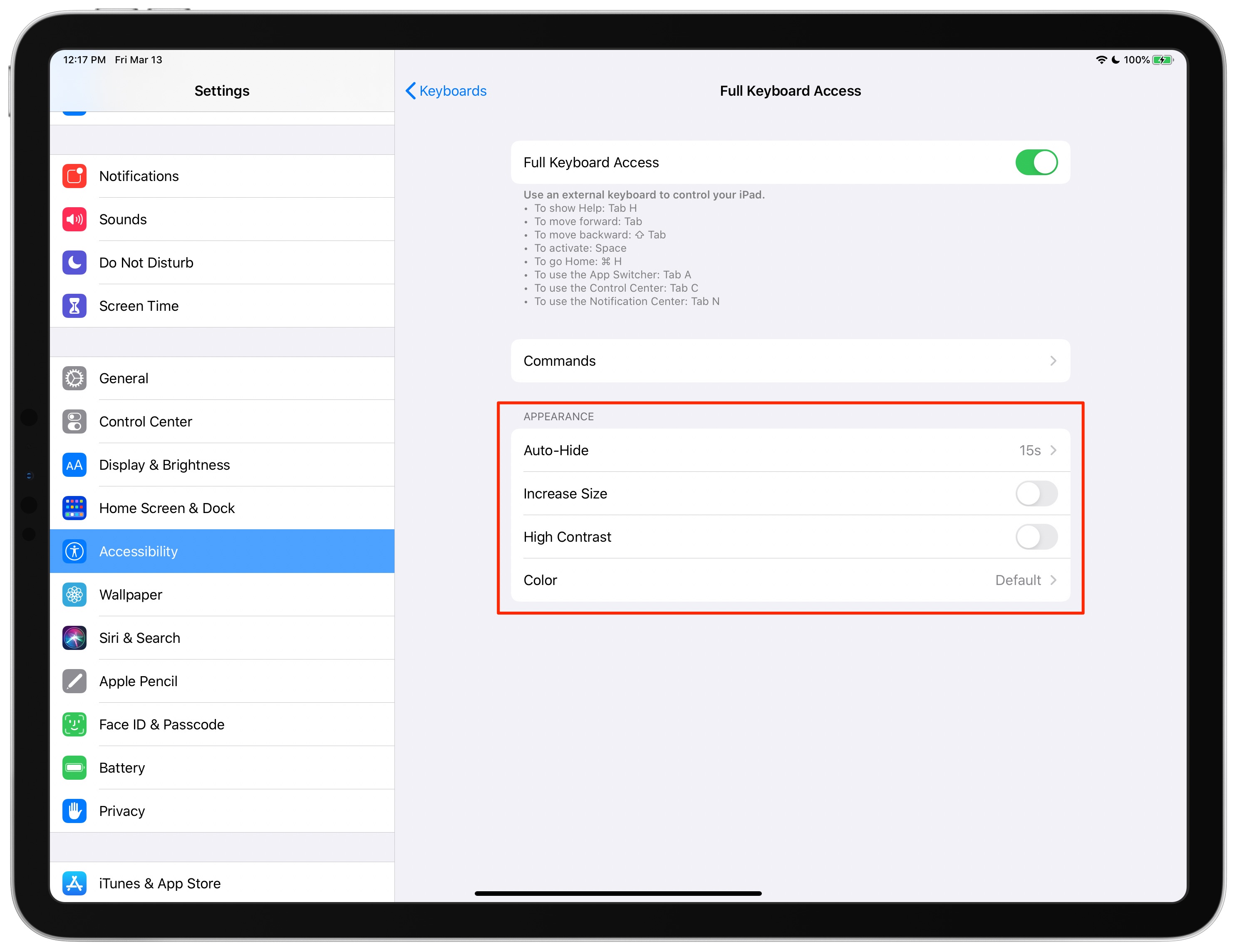
You can change the following focus features to your liking:
- Auto-Hide: The time it takes for the selection rectangle to disappear due to inactivity. The default value is fifteen seconds. To always show the selection rectangle, turn off the option Auto-Hide.
- Increase Size: Enable this option to make the selection rectangle’s outline thicker and easier to spot. This option is off by default.
- High Contrast: Enable this for a high-contrast, black outline for the selection rectangle to better delineate focused content. By default, this option is disabled.
- Color: Change the transparent fill color for the selection rectangle from none to one of the listed colors: gray, white, blue, red, green, yellow, or orange.
And that’s a wrap, girls and boys!
Check out next: How to use Vocal Shortcuts on iPhone or iPad